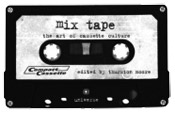Mixtapeology Part I: the history of mixtapes
Before there were file-sharing programs, mp3s, CDRWs and iPods, there was the 90-minute audiocassette. Originally patented as the compact cassette, the tape, as it is commonly known today, was invented in 1964 by the Phillips Company who took the idea of reel-to-reel analog recording technology and shrunk it. It was then licensed to the Sony and Norelco companies. (You may recognize the name Norelco; it was this company that deemed the tape's plastic outer shell the “Norelco shell”)
Since tapes have proven themselves relatively innocent and have been rendered all but useless by far more advanced technology, what is the legacy of the compact cassette? Enter the mixtape. Though it would be impossible to pinpoint the exact date that people started recording different tracks by different artists onto a single hour-and-a-half-long tape, the advent of the mixtape almost immediately sparked a counter-culture revolution, the heart of which beats to this day. It is said that the rise of grunge music, and more specifically the bands which pioneered this genre, can be attributed to college radio and mixtapes. In a steadfast world of Van Halen and Poison, it took the circulation of mixtapes to the North American college radio station managers and the youth population to get the public, en masse, to throw away the aerosol hair spray and don Doc Martins and plaid shirts. But more important than the success of Pearl Jam or Jane's Addiction, is that the act of exchanging mixtapes is the same as that of exchanging ideas. In the Ancient Greek tradition, people were, and are, free to share philosophies, emotions and thoughts through a dozen or so songs that have been carefully considered and chosen to give to others. Mixtapes are a beautifully modern incarnation of active dialogue and should therefore be revered. So hold up your Walkman! Say it loud! Say it proud! Vive la Mixtape!
Join the mixtape renaissance: cool.tapes.revolution@gmail.com
 These little audio novelties remained virtually unnoticed for years, until in the mid- to late 70's Maxwell invented the now familiar UDXL cassette technology. However, it was not until Sony invented both the portable listening device known as the “Walkman” and personal tape recording devices that the masses started turning their LP's into fashionable and funky candy dishes and started playing cool tapes on their jam boxes. This exciting revolution in audio technology however, was not a Saturday-evening-with-no-cover-and-dollar-shots-dance-party for everyone.
These little audio novelties remained virtually unnoticed for years, until in the mid- to late 70's Maxwell invented the now familiar UDXL cassette technology. However, it was not until Sony invented both the portable listening device known as the “Walkman” and personal tape recording devices that the masses started turning their LP's into fashionable and funky candy dishes and started playing cool tapes on their jam boxes. This exciting revolution in audio technology however, was not a Saturday-evening-with-no-cover-and-dollar-shots-dance-party for everyone.
Since tapes have proven themselves relatively innocent and have been rendered all but useless by far more advanced technology, what is the legacy of the compact cassette? Enter the mixtape. Though it would be impossible to pinpoint the exact date that people started recording different tracks by different artists onto a single hour-and-a-half-long tape, the advent of the mixtape almost immediately sparked a counter-culture revolution, the heart of which beats to this day. It is said that the rise of grunge music, and more specifically the bands which pioneered this genre, can be attributed to college radio and mixtapes. In a steadfast world of Van Halen and Poison, it took the circulation of mixtapes to the North American college radio station managers and the youth population to get the public, en masse, to throw away the aerosol hair spray and don Doc Martins and plaid shirts. But more important than the success of Pearl Jam or Jane's Addiction, is that the act of exchanging mixtapes is the same as that of exchanging ideas. In the Ancient Greek tradition, people were, and are, free to share philosophies, emotions and thoughts through a dozen or so songs that have been carefully considered and chosen to give to others. Mixtapes are a beautifully modern incarnation of active dialogue and should therefore be revered. So hold up your Walkman! Say it loud! Say it proud! Vive la Mixtape!
Join the mixtape renaissance: cool.tapes.revolution@gmail.com













